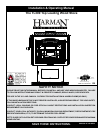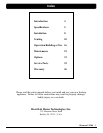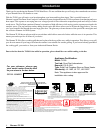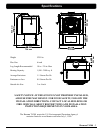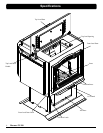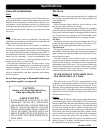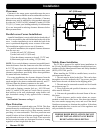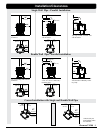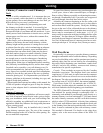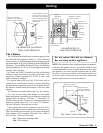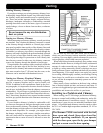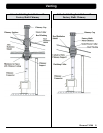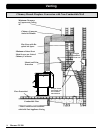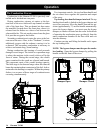
Harman TL300
7
The Stove
Doors
Your stove has a large glass-paneled door for loading and
re viewing, a separate smaller door for removing ashes, and
a top loading door.
Front Door
Before opening, always check for wood, embers, or ash
that may be ready to fall out of the door.
To open the glass door, open bypass damper rst, by pulling
forward on the top load door handle, to the rst position. Then
lift up on the front door handle to disengage the latch, and pull
out. To close the door, push door closed with handle in the
open position, then push handle down to engage the latch.
Ash Door
To open the ash door, open the bypass damper rst. Lift up
on the ash door handle and pull it open. Close the door by
pushing in and pushing the handle all the way down.
Top Load Door
To open the top load door, pull forward on the top load
door handle. The rst position tells you the bypass damper is
open. Continue pivoting the handle toward you until it locks
the top load door open.
All doors must be closed while the stove is in normal
operation, and the gaskets routinely examined for wear and
replaced when necessary. Good door seals are important for
maintaining control of the stove. Never operate with the ash
door open. Operating the stove with the ash door open, or with
a door improperly sealed, could create a serious overring
condition (discussed later in this section).
General Considerations
Draft
Before you install and/or operate your TL300 wood stove,
please read the entire contents of this manual. Pay particular
attention to the explanation of draft and its effect on stove
performance, in the installation section. By following the
installation and operating guidelines, you will ensure proper
draft and gain maximum efciency and enjoyment from
your stove.
Fuel
Your TL300 burns wood very efciently. Here are some
guidelines concerning log size and moisture content that will
help you obtain the best performance.
Select dry seasoned wood. For example, it should be
checked or cracked on the ends and not exposed to rain or
extremely damp conditions. Hardwoods are favored because
they are heavier and contain more heating capacity (BTU’s)
per load than do softwoods. Wood should be split and stored
under cover for “seasoning” - a year is recommended. Your
stove is not an incinerator - do not burn garbage, painted or
treated wood, plastics, or other debris.
Keep the area around the stove free from clutter. Keep
all combustibles, including fuel, beyond the code-required
clearance distance (48" or 1215 mm in the U.S., 1525 mm
or 60" in Canada). Never store fuel in front of the stove
where it could interfere with door operation, safe loading,
and ash removal.
Do not burn garbage or ammable uids such
as gasoline, naptha, or engine oil.
NEVER OPERATE WITH MORE THAN
ONE DOOR OPEN AT A TIME.
The glass used in your TL300 is manufactured to exact
standards to withstand the high heat of the re, but like all
glass, it must be treated with common sense and care. Never
abuse the glass by slamming the door shut or striking the glass
with a heavy object. If the glass is broken or damaged, do not
operate the stove until it has been replaced (See instructions
in Maintenance section.)
Grates
The Harman TL300 has a unique grate system that consists
of one bottom grate, and two front andirons. The bottom grate
has slots which allow the ash to fall into the ash pan by passing
a poker back and forth across the grate. The andirons keep
the fuel from coming into direct contact with the glass, and
keep hot coals and embers from spilling out while reloading.
Never build a re directly against the glass. Andiron exten-
sions (included with each stove) clip onto the xed andirons
and serve to protect the glass when top loading is used as
the primary loading method. The grates and andirons must
remain in place at all times. Do not tamper with or change
the conguration of this grate system.
CAUTION:
Always wear re retardant gloves
when operating the stove.
SAFETY NOTICE
IF THIS HARMAN TL300 STOVE IS NOT
PROPERLY INSTALLED, OPERATED
AND MAINTAINED, A HOUSE FIRE MAY
RESULT. FOR YOUR SAFETY, FOLLOW
INSTALLATION DIRECTIONS. CONTACT
LOCAL BUILDING OR FIRE OFFICIALS
ABOUT RESTRICTIONS AND INSTALLA-
TION INSPECTION REQUIREMENTS IN
YOUR AREA.



